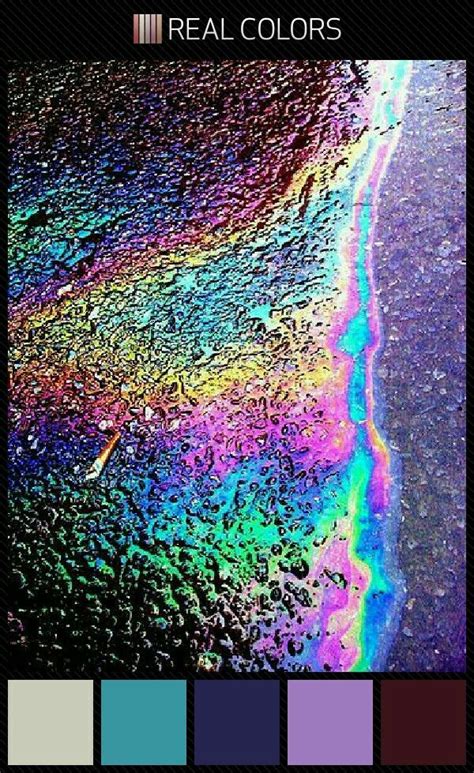Unlocking the Mesmerizing Effects for Design and Art
Oil slick colors, with their captivating interplay of iridescent hues, have mesmerized artists and designers alike for centuries. From shimmering car exteriors to mesmerizing abstract paintings, these vibrant and versatile shades continue to inspire and captivate.

The Science Behind the Rainbow Phenomenon
The mesmerizing colors of oil slicks are a result of interference and diffraction of light on a thin film of oil floating on water. As light passes through the oil film, it interacts with the different layers of oil, causing certain wavelengths of light to be reflected while others are absorbed. This selective reflection and absorption creates the iridescent rainbow effect characteristic of oil slicks.
The RAL Color System: A Guide to Quantifying Oil Slick Hues
The RAL color system, the internationally recognized standard for defining and identifying colors, offers a comprehensive range of oil slick tones. With over 50,000 colors cataloged, the RAL system allows designers to precisely specify and communicate desired oil slick shades for their projects.
| RAL Number | Oil Slick Color | Hexadecimal Code |
|---|---|---|
| RAL 9002 | Pearl White | #F7F7F7 |
| RAL 9028 | Pearl Silver | #B9B9B9 |
| RAL 9032 | Pearl Blue | #8796A7 |
| RAL 9033 | Pearl Green | #929B8A |
Practical Applications of Oil Slick Colors: A Spectrum of Possibilities
The iridescent charm of oil slick colors extends far beyond their decorative allure. Their unique properties render them suitable for a wide range of practical applications, including:
- Automotive Design: Oil slick car wraps enhance aesthetics while protecting vehicles from scratches and fading.
- Product Design: Oil slick appliances and tech gadgets add a futuristic touch to everyday objects.
- Fashion: Oil slick fabrics create eye-catching clothing and accessories that shimmer and change color depending on the viewing angle.
- Interior Design: Oil slick wall paints and furniture add depth and drama to living spaces.
- Art and Crafts: Oil slick inks, paints, and resins create vibrant masterpieces that capture the essence of the natural phenomenon.
Emerging Applications: Unleashing the Potential of “Iridescence Engineering”
As scientists and designers delve deeper into the realm of oil slick colors, they are unlocking new and innovative applications:
- Optical Devices: Oil slick-inspired materials could revolutionize optical technologies, creating lightweight and efficient lenses and filters.
- Security and Counterfeiting: The iridescent patterns of oil slicks are uniquely difficult to replicate, making them promising for anti-counterfeiting and security measures.
- Biosensing: Oil slick-based biosensors could detect and monitor specific biomolecules, enhancing medical diagnostics and diagnostics.
- Energy Harvesting: Oil slick-like films could absorb and convert sunlight into electricity, paving the way for novel solar energy applications.
Color Combinations: Blending Hues to Create Visual Harmony
Choosing the right color combinations is crucial for harnessing the full potential of oil slick colors. Here are some effective strategies to achieve stunning visual effects:
- Monochromatic: Combine different shades of oil slick to create a cohesive and elegant look.
- Analogous: Pair oil slick with neighboring colors on the color wheel to achieve a harmonious effect.
- Complementary: Create contrast and drama by combining oil slick with its complementary color on the color wheel.
- Triadic: Choose three equally spaced colors on the color wheel to create a vibrant and balanced scheme.
Step-by-Step Approach to Incorporating Oil Slick Colors into Your Designs
- Define the Desired Effect: Determine the purpose and mood you want to convey through oil slick colors.
- Choose Color Combinations: Select a harmonious color scheme based on the desired effect and the principles outlined above.
- Select Materials: Explore materials that showcase oil slick colors effectively, such as paints, fabrics, or plastics.
- Apply the Oil Slick Effect: Use techniques such as spray painting, dipping, or resin casting to create the iridescent effect.
- Refine and Enhance: Experiment with different techniques to achieve the optimal intensity and distribution of colors.
Frequently Asked Questions
1. What causes the iridescent colors of oil slicks?
- Answer: Interference and diffraction of light on a thin film of oil floating on water.
2. What is the RAL color system used for?
- Answer: To precisely define and identify oil slick colors for design and manufacturing purposes.
3. Can oil slick colors be used for automotive wraps?
- Answer: Yes, they are widely used to enhance aesthetics and protect vehicles from scratches and fading.
4. What are some emerging applications of oil slick colors?
- Answer: Optical devices, security and counterfeiting, biosensing, and energy harvesting.
5. How can I incorporate oil slick colors into my designs?
- Answer: Follow the step-by-step approach outlined in the “Step-by-Step Approach” section.
